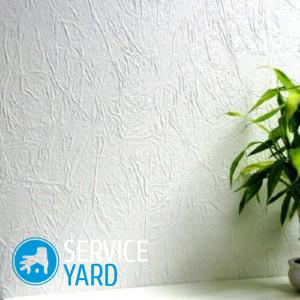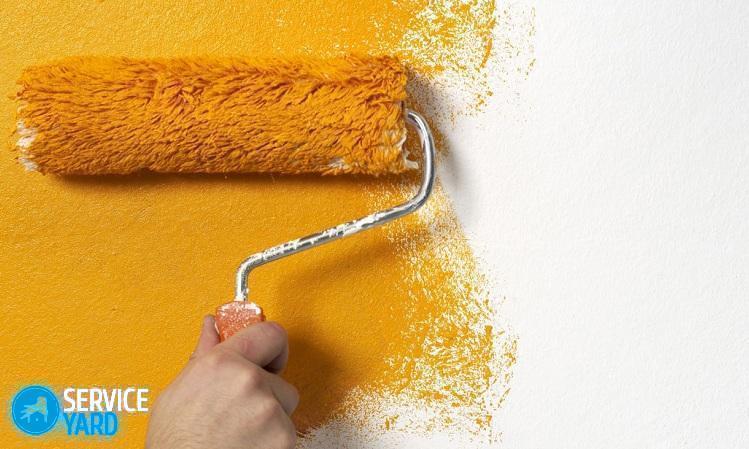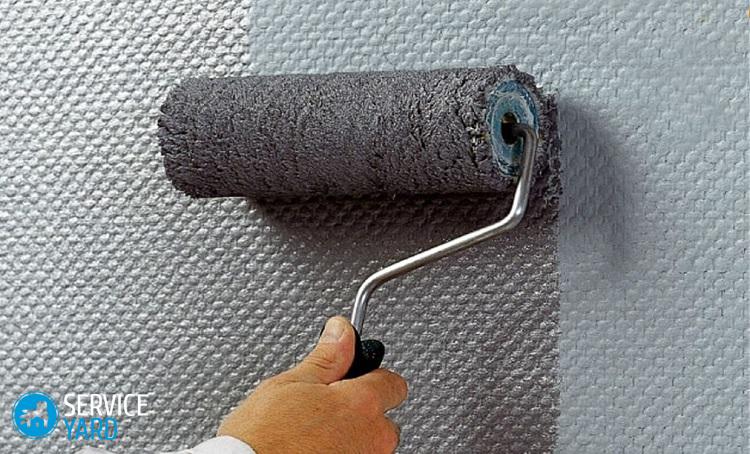Wallpaper painting

So, the repair is nearing completion. Remained the most enjoyable, one might say, creative work - finishing. This type includes wallpaper painting. How correctly you can choose a coloring composition depends on how the room will eventually look. Moreover, it is important to know not only what dye you can cover this or that type of wallpaper, but also all the features of the coloring technology. We will deal with them in this article.
to contents ↑Wallpaper for coloring - features
A large selection of finishing products is presented on the modern market. Wallpaper for painting is a convenient solution for quickly transforming the interior. The color and pattern of the trellis have long lost their relevance, since you can get any shade by adding color to the base of white.
Quantity and quality
Many people ask: how many times is repainting possible? It all depends on the type of wall covering:
- The most durable in this regard are cullets. They can be repainted up to 20 times, and at the same time they retain the original texture.
- Up to 10 stains can withstand non-woven coatings.
- Surfaces glued with paper wallpaper will not withstand more than 4-5 stains. This is not surprising. They are not intended for color change.
Important! Sometimes painted with vinyl thick coating. However, such an undertaking is not always successful. If it didn’t work out beautifully, you will have to dismantle the trellises and stick on new ones.
Wallpaper for coloring is beautiful, but from the very beginning you need to decide which texture you like best - completely smooth, with a pattern (small or large) or structural.
Important! When choosing between paper and paint, choose the latter. Practical, painted wallpapers are likely to displace paper roll materials.
Calculation of paint consumption
To correctly calculate how to paint the wallpaper and how much coloring composition you need to apply to the walls, you need to know:
- The surface area to be painted.
- The amount of paint consumed per square.
- Absorbent properties of the base.
The area to be painted is the sum of the areas of the ceiling (if you need to paint it) and all the walls. From the resulting figure, subtract the total area of the door and window openings.
Important! When purchasing paint, take a little extra in case of unexpected spending or strong absorption.
The amount of paint used is indicated on the packaging. As a rule, the maximum flow rate (in grams per square meter) is.
- For a single layer coating - 180.
- For coating in 2 layers - 250.
Important! Consumption of similar products from different manufacturing companies is different, since dyes have different densities. The flow rate also depends on the type of base to be painted. For example, vinyl or fiberglass absorb liquid worse than non-woven or paper.
An interesting question: do I need to paint wallpaper for painting with my own hands? After all, they themselves look very beautiful. Experts say that if you wish, you can not rush to paint, the walls will not suffer from this. Although, the paint itself is a reliable protection of the walls from dirt.
Choosing the right paint
When purchasing this or that coloring composition, it is necessary to take into account a variety of factors, including the purpose of the room and the material from which the base is made. “Different” type of paint is suitable for different types of substrates:
- Paper - water-based.
- Linkrust - acrylic, oil, wax paste.
- Flizelin painting - water-dispersive.
- Fiberglass - latex, acrylic.
These tips will help you choose a dye, depending on the purpose of the room:
- For the kitchen and bathroom, latex and acrylic paint are best suited. Of course, such a coating cannot be called “breathing”, but such a surface can be washed and it tolerates high humidity well.
- For open and sunny rooms use non-fading latex-based dyes.
Depending on the reflective qualities, these types of paints are distinguished:
- Matt Remarkably mask wall defects, absorb excess lighting.
- Semi-matt.
- Satin. Such dyes are appropriate in the kitchen, bathroom or in the bathroom. They are practical and last a long time.
- Glossy. Suitable for rooms with dim lighting. Glossy compositions are also used to create a “jacquard effect” - staining the relief structure on a matte background.
Important! The easiest paint to apply is water-based. The most durable is considered an acrylic coating. In any case, the paint can not be applied to wet wallpapers. You need to wait 2-3 days until the water from the glue has completely evaporated.
The choice of tools for painting
The most convenient tool is a paint roller. Even a person who is not at all sophisticated in the painting business will be able to work with him. It is permissible to use these types of rollers (each gives its own effect):
- With a pile - long or short. With a short-haired device, only the convex part of the pattern can be rolled. A long-nap roller will solidly paint over the entire surface.
- Foam rubber. Foam rubber gives an interesting effect of “unpainted bubbles” when treated with a smooth surface without pressure.
Important! There are also velor and fur, the use of which is also quite justified for specific purposes.
The paint brush is used in hard-to-reach areas where the roller cannot cope with quality (the space behind the heating appliances, pipes, gaps, crevices).
Specificity of painting - we make the final decision
As already mentioned, the painting technique and the choice of composition, how to paint the wallpaper for painting on the walls, depend on the type of wallpaper. Judge for yourself.
Non-woven
This is one of the best options for painting. The embossed part of the trellis is painted; the smooth side is intended for installation on walls. The latex dye is best suited for non-woven backing. For staining, a fur nozzle is used, and in hard-to-reach areas they act with a brush.
Paper
Trellis made of heavy paper with impregnation is the most budgetary version of the basis for applying paint. They are well suited for the ceiling. Any type of specialized ink is suitable for coloring paper. Since paper and water are not “friends”, it is not necessary to impregnate the coating strongly. One layer is enough.
Important! It is acceptable to apply the second layer if the first is made with numerous flaws. When attaching the panels, it is necessary to ensure that no glue remains on the surface, otherwise - the paint will go badly.
Cullet
This is the most durable base for staining. They are made of fiberglass on quartz sand. They can be coated with paint repeatedly. Fiberglass does not absorb paint, but the composition penetrates between the fibers.
Important! It is necessary to work with cullets in protective clothing and gloves, since wallpaper, like glass wool, is unpleasant for the skin.
The ideal choice for coating glass fiber backing is acrylic and latex. Apply dye in 2 layers. Application of the second layer is permissible only after the first has dried completely.
Vinyl
When stained, vinyl wallpapers give a beautiful multi-layered texture, but working with them requires a certain skill. The ideal option for dye is acrylic. Before applying paint to improve adhesion, the surface is covered with a primer layer.First, with the help of a brush and a long-nap roller, a base layer is applied, and then decorative to highlight the relief.
to contents ↑Important! When applying a decorative layer, a minimum of paint is used.
Staining Procedure:
- Mix the paint in a separate container, gradually adding to the cuvette. Do not forget about the ratio of water and dye provided by the instruction. Well-diluted paint lays on the surface more evenly.
- Pour some paint into a special cuvette so that you can evenly moisten the roller. Now you can start staining.
How to paint wallpaper for painting on the wall? You can achieve a truly effective result by knowing certain secrets and rules:
- Before starting work, test painting is carried out: on a piece of cloth or a section that will subsequently be covered by furniture.
- To create the first primer, the paint is diluted with water at the rate of 10% of the volume. An exception to this rule is fiberglass. It is painted in two dense layers, and the time interval between two stains is at least half a day.
to contents ↑Important! If your walls have withstood several paints, it may happen that the panels began to lag. This is a sign that it is time to dismantle the wallpaper, paste new ones according to the usual standards, and after drying, paint them in accordance with the rules set forth.
Final finish
After the base coat has dried, it is time to realize your creative abilities. On a painted surface, you can apply drawings or patterns. You can protect the walls with colorless varnish. In particular, such protection is relevant in the kitchen, bathroom or bath. If desired, matte or glossy varnish can be used.
to contents ↑Points for and against"
Despite the fact that the popularity of this method of updating the surface is growing exponentially, it is not without some minor drawbacks. Consider all the pros and cons before making the final decision to color the wallpaper.
"Behind":
- An opportunity to realize a variety of design ideas. If there is no suitable shade, it is possible to resort to tinting services or create the desired shade manually yourself.
- Painted walls are easily cleaned from contamination in a wet way.
- Defects, children's drawings and stains that cannot be cleaned can be easily removed with a brush. There is no need to tinker with re-sticking the panels.
- Possibility of multiple staining.
- Arches, corners and other elements of complex configuration are very easy to paint.
"Against":
- The need for thorough wall preparation for a good result.
- The need for an unmistakable selection of paint tools.
- Instability of paints to mechanical damage.
- Dust absorption. This is typical for most of the coloring compounds.
Stock footage
As you can see, painting wallpapers with water-based paint and other compositions gives almost unlimited scope for creativity. You can implement the most daring design plan and create a truly unique interior yourself.
- How to choose a vacuum cleaner taking into account the characteristics of the house and coatings?
- What to look for when choosing a water delivery
- How to quickly create comfort at home - tips for housewives
- How to choose the perfect TV - useful tips
- What to look for when choosing blinds
- What should be running shoes?
- What useful things can you buy in a hardware store
- Iphone 11 pro max review
- Than iPhone is better than Android smartphones






